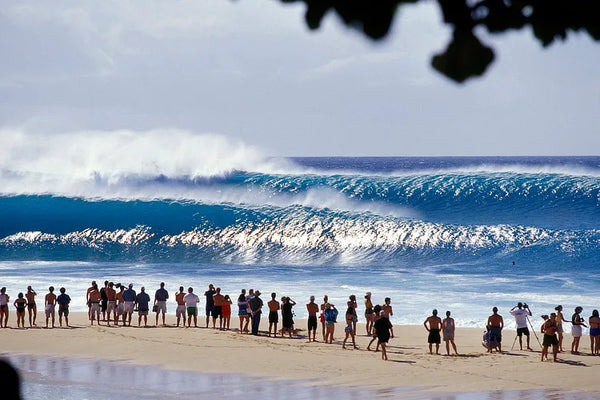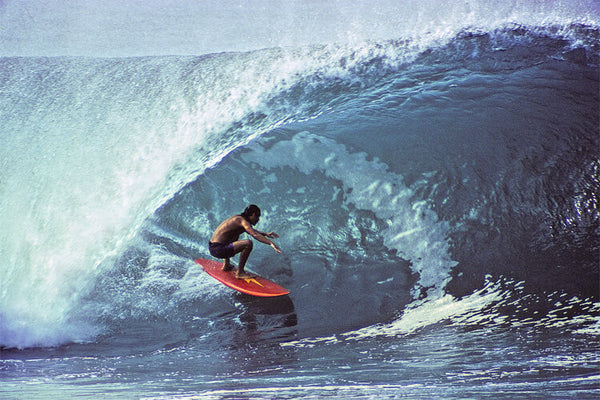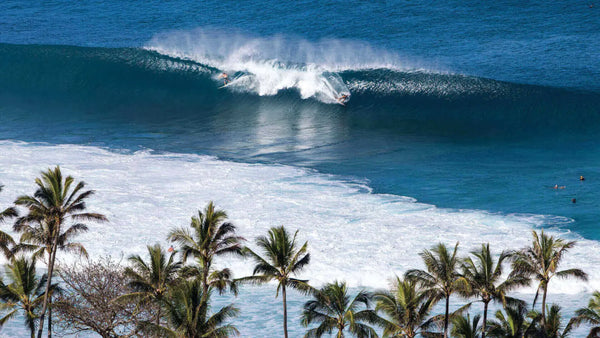Waves of the North Shore Series 4 – Pipeline
Share
Blog series for the best surf spots on North Shore: Pipeline/Backdoor
This winter, Hawaiian South Shore will be presenting a series of blogs about the best surf spots on the North Shore, sharing a bit of their history, how they break, and what makes them tick. From small longboard waves to the original big wave spot—not to mention the deadliest barrel on the planet—the Seven-Mile Miracle has it all. Whether you are new to the Country or have surfed these waves your entire life, join us as we dive into the best spots on the North Shore.

Photo: Sean Davis
The Reef Break Known as Pipeline
The reef break known as Pipeline holds many titles in surfing. It’s the barrel against which all other are measured—the first heavy tube to captivate the imagination of the surf community, and still the most important barrel in the sport. It’s the most dangerous and deadly wave on the planet, having killed and injured more people than any other spot. It’s the most important wave on the North Shore, which itself is the center of the surfing universe. Of course, that has led to Pipeline being one of the most respected and revered waves in the world, but also one of the most crowded.
The Pipe Masters has been one of the most important contests in the sport since the first year it ran, and the various other events (including the Pipe Pro, Backdoor Shootout, and World Tour event there) are all nearly as celebrated. And perhaps most importantly, it has featured in more surf films and magazine photos than any other spot in existence, which has burned the image of this magnificent peak into our collective consciousness for over 50 years.
The History of Pipeline
Pipeline was first surfed by Phil Edwards in 1961, but it is generally agreed that the first session in proper Pipeline waves was surfed by Butch Van Artsdalen and John Peck a few years later. They were two of the hardest charging surfers in the world at the time, and challenged the infamous wave on traditional longboards.
Over the next 10 years, it quickly became the most covered wave in the surf media—and subsequently the most important wave in all of surfing. The minigun was essentially designed specifically for the barrels of Pipeline, but quickly went on to revolutionize surfboard design. Lightning Bolt boards, in particular, became one of the biggest brands in surfing in the 1970s, almost exclusively due to the performances of “Mr. Pipeline” Gerry Lopez at the reef break located just west of Ehukai Beach Park.
“Mr. Pipeline” Gerry Lopez

Photo Courtesy: Surfertoday.com
Competitors and Dangers
Many of surfing’s best competitors proved themselves at Pipeline over the next 50 years. Mike Ho’s win while wearing a cast on his broken arm is the stuff of Pipe Masters legend, as is Tom Carrol’s “Snap,” Andy Iron’s mid-2000s dominance, and the high five between Rob Machado and Kelly Slater. Speaking of Slater, he is the winningest competitor of all time at Pipeline, having won the Pipe Masters a record six times. Other surfers who have dominated their generations at Pipe include Jamie O’Brien and John John Florence.
Of course, the glory of Pipeline is not without its price, and many high-profile surfers have gone down hard there. Dusty Payne went face-first into the reef at Backdoor in what was almost a career-ending injury. Local musician Jack Johnson gave up a buddying career as a semi-pro surfer after suffering a similar injury. Owen Wright went head-first into the reef at Pipeline during competition and spent a year recovering from a traumatic brain injury, and Bede Durbidge destroyed his hip getting driven into the bottom there. And only a few weeks ago, top five-ranked world tour surfer Joao Chianca hit his head and was rendered unconscious, suffering a three-wave hold down that resulted in a hospitalization.
Of course, that’s to say nothing of the tragic deaths that have happened at Pipeline, perhaps the most high-profile of which was beloved Tahitian pro surfer Malik Joyeux.
The Wave Conditions and Swell Direction
Despite the dangers, Pipeline remains one of the most popular waves in the world—and for good reason. For anyone who enjoys riding big, heavy barrels, nowhere else really compares. And for spectators, Pipe is and has always been the greatest show on Earth. Breaking a mere feet from shore, the peak breaks both left and right (with the left being called the Banzai Pipeline, or simply “Pipe,” and the right being called Backdoor). Both waves are as heavy and shallow as they come, offering up spitting barrels from 3 to 10 foot Hawaiian.
Pipeline prefers a west or northwest swell, and on a good day produces huge barrels that shoulder off perfectly in a small channel in the reef. Meanwhile, Backdoor works on northwest to north/northwest swells, and is a less predictable prospect, often running fast and closing out on the reef down by Off-the-Wall. However, the ones that stay open are absolutely amazing, and the Wave of the Winter is often ridden at Backdoor.
When the swell gets bigger than eight foot, Second Reef Pipe starts to break. This reef, located 50 meters outside of the normal Pipe peak, offers a roll-in to those confined to the left at Pipe, as Backdoor doesn’t really work when the swell gets that big (and the consequences on the ultra-shallow reef on the right are too high).

Ola Eleogram and Eli Olson Photo: Tony Heff
There’s also a third reef outside of Pipeline—a legitimate outer reef that starts to break at around 12 foot Hawaiian, essentially turning the Pipeline lineup into a washed-out mess that only appeals to bodyboarders and suicidal lunatics. But regardless of the size that you surf Pipe, it’s always heavy, shallow, and crowded—in other words, it’s one of the scariest, most challenging waves in existence. No wonder it’s the heart of the coast they call the Proving Ground.
The Da Hui Backdoor Shootout 2024 was also held in this Surf Spot. It is one of the most exciting surf contests. Held at the iconic Pipeline break on O'ahu's North Shore when the waves are pumping where this team event offers thrilling action.
What makes the Shootout unique is its focus on various surf crafts beyond traditional shortboards. The men's and women's divisions feature surfers riding longboards, stand-up paddle boards, and even bodysurfing without boards.
More to Read📚🔎
WAVES OF THE NORTH SHORE SERIES 1 – VELZYLAND
